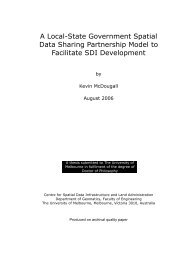The Danish Way - Centre for Spatial Data Infrastructures and Land ...
The Danish Way - Centre for Spatial Data Infrastructures and Land ...
The Danish Way - Centre for Spatial Data Infrastructures and Land ...
You also want an ePaper? Increase the reach of your titles
YUMPU automatically turns print PDFs into web optimized ePapers that Google loves.
SHORT HISTORICAL PATH TOWARDS SUSTAINABLE LAND MANAGEMNT<br />
<strong>The</strong> <strong>Danish</strong> cadastre, which derived from the enclosure movement, was established in 1844.<br />
<strong>The</strong> main purpose was the collection of l<strong>and</strong> taxes from agricultural holdings based on a<br />
valuation of the yielding capacity of the soil. From the very beginning, the cadastre<br />
consisted of two parts: the cadastral register <strong>and</strong> the cadastral maps. Both these components<br />
have been updated continually ever since.<br />
In the late 1800´s the cadastre changed from being a fiscal cadastre primarily as a basis <strong>for</strong><br />
l<strong>and</strong> valuation <strong>and</strong> taxation to a legal cadastre supporting a growing l<strong>and</strong> market. This<br />
evolution was completed in the early part of the 1900´s when taxation became based on the<br />
market value. Simultaneously, in the 1920´s a new L<strong>and</strong> Book System was established. <strong>The</strong><br />
new system was based on the cadastral identification <strong>and</strong> a close interaction between the<br />
two systems was established.<br />
During the first half of the 1900´s l<strong>and</strong> was increasingly seen as a commodity <strong>and</strong> the focus<br />
was on agricultural production <strong>and</strong> industrial revolution. L<strong>and</strong> use regulations were<br />
introduced to improve agricultural productivity <strong>and</strong> at the same time sustain the social<br />
conditions in the rural areas. <strong>The</strong>se regulations were based on cadastral in<strong>for</strong>mation. <strong>The</strong><br />
1960´s introduced a close interaction between the cadastral process (e.g. subdivision) <strong>and</strong><br />
the relevant l<strong>and</strong>-use regulations.<br />
An administrative re<strong>for</strong>m was adopted in the early 1970´s to reorganise regional <strong>and</strong> local<br />
administration. <strong>The</strong> re<strong>for</strong>m reduced the number of counties from 25 to 14 <strong>and</strong> the number<br />
of local authorities from almost 1,400 to 275. <strong>The</strong> reorganisation created the basis <strong>for</strong><br />
transferring a number of responsibilities <strong>and</strong> decision-making power to the counties <strong>and</strong><br />
especially to the municipal councils by means of decentralisation<br />
L<strong>and</strong> was increasingly seen as a community scarce resource <strong>and</strong> zoning <strong>and</strong> planning<br />
regulations were introduced to control l<strong>and</strong> development. Environmental concerns<br />
appeared in the late 1970´s <strong>and</strong> developed into the major issue in recent years. Today,<br />
comprehensive planning <strong>and</strong> environmental protection are seen as the main tools to secure<br />
sustainable development. Cadastral in<strong>for</strong>mation based on a modern IT plat<strong>for</strong>m evolved to<br />
support these processes towards sustainable l<strong>and</strong> management (Enemark <strong>and</strong> Schoeler<br />
2002).<br />
THE CURRENT LAND ADMINISTRATION SYSTEM<br />
<strong>The</strong> L<strong>and</strong> Administration System in Denmark is tailored <strong>for</strong> a decentralised approach to<br />
l<strong>and</strong>-use management placing the decision-making power at regional <strong>and</strong> especially local<br />
level. <strong>The</strong> system works well in the sense that it supports sustainable development through<br />
an efficient l<strong>and</strong> market <strong>and</strong> effective l<strong>and</strong>-use management.<br />
3







